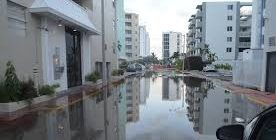
Journalist and author Jeff Goodell opened his discussion with the National Climate Seminar (hear his complete talk here) by apologizing for the call quality. As he explained, the WiFi signal isn’t reliable in Viequis, a small island off the coast of Puerto Rico, where he is reporting on the region’s slow recovery from Hurricane Maria.
The impacts of climate change are especially visible when storm surges devastate regions like Puerto Rico, but Goodell’s discussion focused on a topic that gets less media attention. Although he has built a career reporting on climate change, even Goodell spent years ignoring the looming threat of sea level rise.
That is, until Hurricane Sandy provided a stunning demonstration. The image of flooded Lower Manhattan streets was impossible to ignore, and so was the $25 billion in damage. According to Goodell, this was just a preview of what nine feet of sea level rise will do to coastal cities around the world. In his book The Water Will Come, Goodell explores the implications of sea level rise and the ways that civilization may adapt to the new landscapes defined by shifting shorelines in the 22nd century.

The poster city for sea level rise is Miami. The city is in demand: real estate commands a median price of nearly $200 per square foot (compare that with a national average of $139 per square foot). But this booming real estate market belies the rapidly changing nature of Miami’s coast.
During the king tides, sections of Miami are already under three feet of water, and this is just the beginning. Sea level rise is inevitable. No one is quite sure how much of a rise we’ll see by the end of the century, but projections are as high as roughly seven feet. For a city like Miami, which has an average elevation of just six feet above sea level, rising oceans pose a threat that’s impossible to ignore.
Miami is pouring resources into adapting to this reality—hundreds of billions of dollars have gone toward projects such as elevating public streets and installing floodwater drainage pumps—but there is a limit to how much we can engineer our way out of sea level rise. The city is situated on a bedrock of porous limestone, which is unable to support a strong seawall, so the rising ocean can’t be stopped. Just this summer, the multi-million dollar drainage pumps failed in Tropical Storm Emily. As the shoreline closes in, Florida will face even bigger challenges. Who will pay to move the airport when runways are underwater? How can sewage lines be maintained?

Cities around the world are facing similar challenges. There are plans to construct a barrier around Manhattan to protect against rising waters. But when walls go up, some people are left on the outside. Even if a seawall could help Wall Street, what would become of lower-income communities like the waterfront area of Red Hook, Brooklyn?
The floating slum of Makoko outside Lagos, Nigeria provides a possible template for coastal communities of the future. Living in elevated houses and traveling by canoe, the people of these water slums adapt easily to changing water levels. Of course, most people won’t be interested in that lifestyle, and many won’t have the option at all.
Millions of people will be forced to leave their communities. Climate migration is already a reality for people from the Outer Banks of North Carolina to sinking Pacific islands such as the Maldives and the Marshall Islands. As coastal cities are inundated and inland or upland cities swell to contain the millions of migrants, sea level rise will redefine human civilization in the next century.
“We have to rethink our relationship with water,” Goodell says. The delineation between land and sea is not a solid line on a map, and over the next century that fact will be more obvious than ever before. How we will adapt to sea level rise is still in question: New York’s seawalls, Miami’s elevated roads and drainage pumps, Makoko’s stilt houses and canoe travel, or (more likely) some combination of strategies.
According to Goodell, the appropriate policy choices vary widely depending on a region’s culture and geography. The only unacceptable option is not to act at all.

